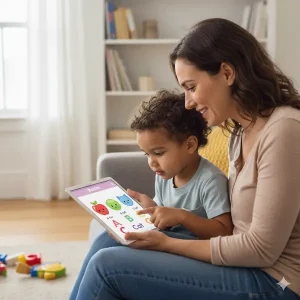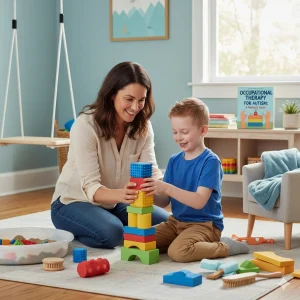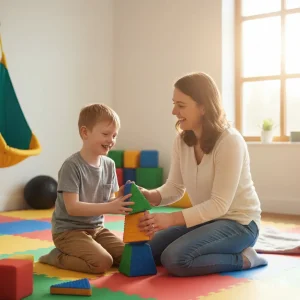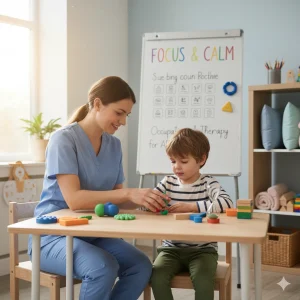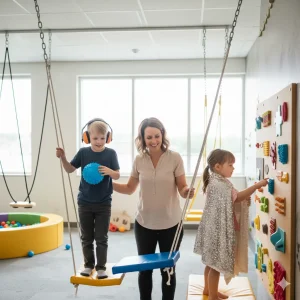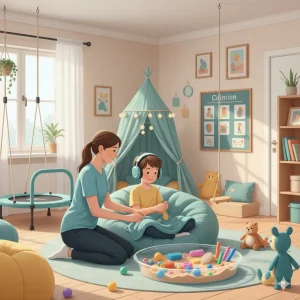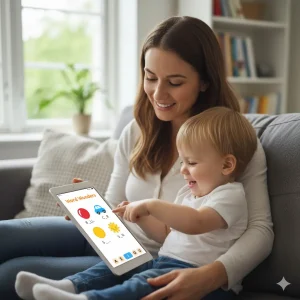Why Your 3-Year-Old May Avoid Back-and-Forth Conversations
Last Updated: August 12, 2025
As a parent, you may have noticed that your 3-year-old child is hesitant to engage in back-and-forth conversations, leaving you wondering if this is a normal part of their development. Speech delay in toddlers can impact their ability to participate in these key interactions. Back-and-forth conversations are a crucial milestone in language development, where children take turns talking and responding—something that typically starts around the age of 2 or 3. However, when this milestone seems delayed or absent, it can be a sign of underlying speech delay or other communication issues.
If your toddler struggles with this kind of interaction, you’re not alone. Many children experience delays in speech and social communication, especially when dealing with conditions like autism spectrum disorder (ASD) or selective mutism. In this article, we’ll explore the possible reasons behind this behavior, offer insights on early speech development, and provide practical tips to encourage your child to engage in conversations. By understanding why your 3-year-old may avoid back-and-forth conversations, you’ll be better equipped to support their language development and take action if needed.
Free Speech Help for Kids
Concerned about speech delays? Book a free consultation with our expert speech therapist and get guidance tailored to your child’s needs.
What Are Back-and-Forth Conversations and Why Are They Important?
When you think about the early stages of communication, what often comes to mind is the simple act of speaking and listening. As parents, you might notice that your toddler begins to respond to your questions or imitate what you say. This simple exchange of words is known as back-and-forth conversations, and it’s one of the most important milestones in language development for young children.
Back-and-forth conversations are the natural rhythm of communication that involves taking turns in a conversation. For example, when you ask your 3-year-old, “What’s your favorite color?” and they respond, “Blue,” you might follow up with another question, like “What color is the sky?” Your child then responds, continuing the flow of interaction. These exchanges, though simple, are essential in teaching your child how language works—understanding how words, questions, and responses come together to create meaningful communication.
The Role of Back-and-Forth Conversations in Toddler Speech Milestones
Back-and-forth conversations are more than just a way to pass the time—they are a crucial aspect of toddler speech milestones. By age 3, children typically begin to engage in these interactive exchanges, which are a sign of growing language development. These conversations show that your toddler is learning how to:
- Understand language: They grasp the meaning behind the words you use and can process the questions you ask.
- Express themselves: Through their responses, your child practices using words to convey thoughts, feelings, and ideas.
- Develop listening skills: Your toddler is learning to wait their turn, listen to others, and respond appropriately, which is key to effective communication.
In the early years, back-and-forth conversations are a great indicator of a child’s progress in mastering language. As they navigate these interactions, they begin to understand the flow of conversations, recognize tone and rhythm, and learn how to structure their thoughts in a way that makes sense to others.
Linking Back-and-Forth Conversations to Cognitive and Social-Emotional Growth
The importance of back-and-forth conversations extends beyond language development. They play a significant role in your child’s cognitive and social-emotional growth. Here’s how:
- Cognitive Development: As toddlers engage in conversations, they are not just repeating words but also processing information. They learn how to think critically, follow sequences, and respond to new ideas. These skills contribute to their ability to problem-solve, remember details, and reason through situations.
- Social-Emotional Growth: Conversations are also deeply tied to your child’s emotional and social development. Through back-and-forth exchanges, children learn empathy, social cues, and how to interact with others in a meaningful way. They begin to understand the concept of feelings—both their own and others’. For instance, when a toddler answers a question about how they feel, they learn to label and express their emotions, which is a key part of emotional intelligence.
By fostering these early conversational exchanges, you are helping your child develop not just their ability to speak but their ability to connect with others, understand themselves, and make sense of the world around them.
Possible Reasons Why Your 3-Year-Old Avoids Conversations
As a parent, it can be concerning when your 3-year-old isn’t engaging in the back-and-forth conversations that are typical at this stage of development. While some children may be naturally shy or introverted, there could be underlying factors that affect their ability or willingness to communicate. If your toddler is struggling with conversation skills, it’s important to understand the potential reasons behind their challenges. Below, we’ll explore several possible causes of toddler communication issues, including speech delay, autism, and selective mutism.
1. Speech Delay: Difficulty with Verbal Expression or Comprehension
One of the most common reasons a 3-year-old may avoid conversations is due to a speech delay. A speech delay refers to a slower-than-usual development of verbal communication skills. This might include difficulty pronouncing words, understanding what others say, or expressing thoughts clearly.
There are a few key signs of speech delay:
- Limited vocabulary: At age 3, most children can speak in simple sentences and use a range of words. If your toddler struggles to put words together or has a very limited vocabulary, they may avoid conversations out of frustration.
- Difficulty following instructions: If your child seems confused when given simple directions or doesn’t respond to questions, it could be a sign that they are struggling to understand language.
- Trouble articulating thoughts: Some children with speech delays may know what they want to say but have difficulty finding the words. This may cause them to become quiet during conversations, avoiding communication altogether.
Why it matters: Speech delays can affect not just communication but also emotional development. Children who can’t express themselves may become frustrated or withdrawn, which can lead to social difficulties. Early intervention, such as working with a speech therapist, can help your child catch up and engage more effectively in conversations.
2. Autism Spectrum Disorder (ASD): How It Affects Speech and Social Interaction
Another possible reason for a child’s reluctance to engage in conversations could be autism spectrum disorder (ASD). Autism is a developmental condition that can significantly affect a child’s speech and social development. While each child with autism is unique, many experience difficulties with verbal and non-verbal communication, social interaction, and understanding social cues.
In children with ASD, some common signs of autism and speech development issues include:
- Delayed speech development: Some children with autism may not start speaking until later than their peers. They may not use words or may have difficulty understanding or using words in a meaningful way.
- Limited social communication: Children with ASD often struggle with understanding and participating in social interactions. This includes difficulties with turn-taking in conversations, understanding facial expressions, and using language to engage with others.
- Repetitive language: Children on the autism spectrum may exhibit echolalia, where they repeat phrases or words they’ve heard, rather than engaging in back-and-forth conversation.
Why it matters: Communication challenges in children with autism are often linked to broader difficulties in social skills and emotional regulation. Speech and language therapy, along with tailored educational strategies, can help children with ASD improve their communication and social interaction skills, allowing them to engage more meaningfully with others.
3. Selective Mutism: A Psychological Condition That May Cause Children to Avoid Speaking in Specific Situations
Another less common but important condition that may cause a 3-year-old to avoid conversations is selective mutism. This is a psychological condition where a child who is normally capable of speaking is unable to speak in certain social situations, such as in public or in the presence of unfamiliar people. While selective mutism is often associated with anxiety, it can affect a child’s ability to participate in conversations, even at home or with familiar family members.
Here are some signs that a child may have selective mutism:
- Speaking freely at home, but not in other settings: A child with selective mutism may be perfectly verbal and communicative in a comfortable environment, like their home, but suddenly become nonverbal in social situations like preschool or when interacting with strangers.
- Anxiety or fear in social settings: These children often experience anxiety, which makes speaking in certain environments feel overwhelming. They might exhibit signs of discomfort, such as avoiding eye contact or becoming physically tense when asked to speak in public.
- Reluctance to communicate: Even if they have the ability to speak, children with selective mutism may avoid conversations altogether, particularly when they are asked to speak in a group or unfamiliar context.
Why it matters: While selective mutism can be challenging, it’s important to understand that it’s not about refusing to speak—it’s often driven by anxiety. Treatment typically involves behavioral therapy and gradually increasing the child’s comfort level with speaking in different situations.
Signs of Speech and Language Delays in 3-Year-Olds
As parents, it’s natural to be concerned when your 3-year-old isn’t meeting the expected speech milestones. Communication is a vital part of a child’s development, and it’s important to recognize the signs of speech delay or language delay signs early on. Addressing these challenges promptly through early intervention for speech delays can significantly improve your child’s language skills, boosting their confidence and social interactions.
Here, we’ll explore the common signs of speech delay in toddlers and provide helpful tips on when to seek professional guidance from a speech therapist or pediatrician.
1. Limited Vocabulary for Their Age
One of the most noticeable language delay signs is a limited vocabulary. At 3 years old, most children can use a variety of words to express themselves. They should be able to say between 200 and 1,000 words, depending on their developmental pace.
Signs to watch for:
- Fewer words than expected: Your child may only be able to use a handful of words, instead of forming short phrases or sentences.
- Difficulty naming objects or people: When you ask your child to name familiar objects or family members, they may struggle or remain silent.
Why it matters: A limited vocabulary could indicate that your child is having trouble processing or expressing language, and early intervention is crucial for helping them catch up.
2. Difficulty Combining Words into Sentences
By the age of 3, toddlers typically begin combining two to three words into simple sentences. If your child is still mainly using single words or only repeating phrases, it might signal a speech delay.
Signs to watch for:
- Limited sentence structure: Instead of saying “I want cookie,” your child may simply say “cookie” or “want.”
- Struggling to form questions or statements: Your child might not yet be able to ask questions like “Where’s my toy?” or make simple statements like “I’m hungry.”
Why it matters: Difficulty combining words into sentences can delay your child’s ability to communicate their needs and emotions effectively. Speech therapy can help children form more complex sentence structures and engage more meaningfully in conversations.
3. Trouble Understanding Simple Instructions
By age 3, children should be able to follow basic instructions like “Please pick up your toys” or “Give me the ball.” If your child is having trouble understanding simple directions, it could be a sign of a language delay.
Signs to watch for:
- Not responding to questions or commands: When asked to perform simple tasks, your child might not respond or might not understand what’s being asked.
- Repetition of words without understanding: Your child may repeat words or phrases you say without fully understanding their meaning.
Why it matters: A child who struggles to understand instructions might have difficulty engaging in conversations, which can affect both their social interactions and learning. Seeking early intervention for speech delays is key to addressing comprehension issues.
4. Limited Social Interaction or Difficulty with Conversational Turn-Taking
Communication is about more than just speaking—it’s about interacting with others. A child who avoids or struggles with back-and-forth conversations may be showing signs of language delay or speech delay.
Signs to watch for:
- Avoiding eye contact: If your child consistently avoids eye contact or seems uninterested in engaging with others, it may point to a speech or social delay.
- Not engaging in pretend play: Pretend play, such as pretending to talk on the phone or playing house, is a sign of healthy language development. A child who avoids these activities may have difficulty with verbal communication.
Why it matters: Social interactions are vital for language growth. Children who don’t engage in conversational exchanges may struggle with emotional development and building relationships with peers.
5. Pronunciation Issues or Difficulty Being Understood
By age 3, many children have mastered common sounds like “b,” “p,” “m,” and “d,” and can use them correctly in words. If your toddler is still making frequent pronunciation errors or is hard to understand, it could be a sign of a speech delay.
Signs to watch for:
- Frequent speech errors: Your child may have difficulty pronouncing common words, or they may omit sounds (e.g., saying “ca” instead of “cat”).
- Speech is unclear to others: Family members may be able to understand your child, but others outside the immediate family may struggle to make sense of what your child is saying.
Why it matters: Clear speech is essential for effective communication. While some mispronunciations are typical, persistent issues can impact a child’s ability to connect with others and express themselves clearly.
6. Limited Use of Gestures or Non-Verbal Communication
At this age, children typically begin to use more than just words to communicate, such as pointing, waving, or nodding. If your child isn’t using gestures to express themselves, it could be a sign of a language delay.
Signs to watch for:
- Not using gestures: A child who doesn’t point at objects, wave goodbye, or use facial expressions might have challenges with communication.
- Relying solely on non-verbal cues: If your child is not using words but still communicates through gestures, it might indicate a delay in their speech development.
Why it matters: Non-verbal communication is an important precursor to verbal communication. If your child isn’t using gestures or facial expressions, they may need extra support to develop full language skills.
When to Seek Help: Early Intervention for Speech Delays
If your child is showing one or more of these language delay signs, it’s important to seek guidance from a professional as soon as possible. Early intervention for speech delays is essential for helping children overcome these challenges and catch up to their peers. A speech therapist can assess your child’s language development and provide strategies to support them.
Signs You Should Seek Professional Help:
- No words by 18 months or very limited speech by 2 years.
- Not using two-word combinations by age 2.
- Significant difficulty being understood or consistently using gestures instead of words by age 3.
- Consistent difficulty following simple instructions or understanding simple words by age 3.
- Lack of interest in social interaction or limited back-and-forth conversations.
If you’re concerned about your child’s speech or language development, consult a pediatrician or speech therapist. They can help identify any underlying issues and provide the necessary support and resources to help your child thrive.
The Role of Social and Emotional Development in Conversation Skills
As your toddler reaches the exciting milestones of language development, one of the most crucial elements that can influence their ability to engage in back-and-forth conversations is their social and emotional development. While speech and language skills are important, a child’s emotional development and communication skills play a key role in how they interact, respond, and engage with others. This connection between social-emotional growth and early childhood communication skills is essential to understanding why some children may struggle to participate in conversations, even if their vocabulary is developing well.
Understanding Social Development in Toddlers
Social development in toddlers refers to how children learn to interact with others, form relationships, and understand social cues. Around the age of 2 to 3, children begin to explore the world beyond their immediate family and develop interactions with peers and adults. These early social experiences are crucial for communication because they teach toddlers about taking turns, understanding different perspectives, and responding to emotions.
When children begin to develop social skills, they learn how to engage in conversations naturally. They start to understand the basic flow of interactions—how to wait for their turn to speak, how to ask questions, and how to listen and respond appropriately. If a child’s social development is delayed or if they have trouble understanding how to engage with others, it can impact their ability to converse. For example, a toddler who hasn’t yet mastered social cues like making eye contact or waiting for someone to finish speaking may struggle with back-and-forth conversations.
The Link Between Emotional Development and Communication Skills
Just as social development is important for fostering effective communication, so too is emotional development and communication. A child’s emotional readiness is an essential factor in how they communicate, especially when it comes to participating in conversational exchanges. For toddlers, emotional development involves understanding their own feelings and recognizing the feelings of others, which is foundational to building strong communication skills.
How Emotional Readiness Impacts Communication:
- Self-awareness: Children who are aware of their own feelings are better equipped to express themselves verbally. If a child understands that they are feeling happy, upset, or frustrated, they can use words to express those emotions in a conversation. For example, a child who says, “I’m sad because my toy broke,” is demonstrating not just vocabulary, but emotional awareness, which is key to engaging in meaningful conversations.
- Empathy: As toddlers learn to recognize and understand the emotions of others, they begin to engage in emotional exchanges. This allows them to respond appropriately during conversations. For instance, when a friend is upset, an empathetic child may offer comfort, ask questions, or suggest ways to help. This exchange goes beyond words—it’s about understanding the emotional context behind what’s being said.
- Emotional regulation: Toddlers who can manage their emotions are more likely to participate in conversations. A child who becomes easily frustrated or upset may find it difficult to take turns or listen attentively. In contrast, children who have learned to manage their emotions can engage in conversations more effectively because they’re able to stay calm, focused, and responsive.
Building Emotional Readiness for Conversations
As much as toddlers need to develop the mechanics of speech, they also need to develop the emotional readiness to engage in conversations. It’s not enough to know how to say words—they need to feel comfortable expressing themselves emotionally and understand how their feelings can impact their interactions.
Supporting Emotional Readiness:
- Model emotional expression: Parents and caregivers can help toddlers learn how to express their emotions by modeling these behaviors. Saying things like, “I’m feeling frustrated because I can’t find my keys,” teaches toddlers how to talk about their emotions, which they can then apply in conversations with others.
- Encourage empathetic play: Activities like role-playing, where toddlers can take on different roles (e.g., doctor, teacher, friend), help children practice responding to various emotions and scenarios. This builds their emotional vocabulary and improves their ability to understand the feelings of others during real-life conversations.
- Promote social interactions: Encourage your toddler to play and interact with other children. These peer interactions help develop social communication skills—such as sharing, turn-taking, and responding to others’ needs—that are vital for participating in back-and-forth conversations.
Why Social and Emotional Development Is Key to Back-and-Forth Conversations
Back-and-forth conversations require more than just the ability to speak; they require a balance of social understanding and emotional awareness. Toddlers must not only know how to use words but also how to interpret the social context of a conversation. This means recognizing the cues that signal when it’s their turn to speak, understanding the tone of voice used by others, and knowing how to respond appropriately to social situations.
A toddler with well-developed social and emotional skills will find it easier to:
- Engage in conversational turn-taking without becoming frustrated or disengaged.
- Listen and respond to questions or statements, showing understanding and empathy.
- Navigate different social scenarios, such as expressing curiosity, asking questions, or offering comfort when needed.
On the other hand, a child who is still learning how to manage their emotions or navigate social interactions may become overwhelmed or unsure of how to proceed in a conversation. This can lead to silence, frustration, or withdrawal.
Supporting Your Toddler’s Social and Emotional Growth for Better Conversations
It’s important for parents and caregivers to support their child’s social development and emotional readiness through activities and interactions that nurture these skills. Here are a few tips to help guide your toddler toward better conversation skills:
- Provide opportunities for social interaction: Playdates, group activities, and family conversations help toddlers practice turn-taking, listening, and responding.
- Use emotion-based stories: Books or stories that highlight different emotions (happy, sad, angry) help toddlers understand and label their feelings, making it easier for them to use words to express themselves.
- Create a safe and supportive environment: Encouragement, praise, and patience help toddlers feel comfortable expressing themselves and engaging in conversations, without the fear of making mistakes.
How to Encourage Back-and-Forth Conversations with Your 3-Year-Old
One of the most rewarding aspects of parenting is watching your toddler start to engage in back-and-forth conversations. But getting to this point can sometimes be challenging. If your 3-year-old is still struggling with verbal exchanges, don’t worry—there are many effective ways to encourage conversation with toddlers. In fact, with a bit of patience and some fun, interactive techniques, you can make significant progress in improving your child’s communication skills.
Here are some practical tips that can help your child feel more comfortable with conversation, while fostering speech development in a positive and supportive way:
1. Modeling Speech and Waiting for Responses
One of the best ways to teach your toddler to engage in conversation is by modeling speech yourself. Toddlers learn a great deal by observing and imitating adults, so when you speak clearly and calmly to them, you’re providing an important foundation for their own speech development.
How to Model Speech:
- Speak at your child’s level: Use simple, clear language that is easy for them to understand. For example, instead of saying, “Can you please pass me the small blue object?” try, “Can you give me the blue ball?”
- Ask open-ended questions: Encourage your toddler to respond by asking questions that require more than just a “yes” or “no.” For instance, instead of saying, “Do you like the toy?” you could say, “What do you like about the toy?”
- Give your child time to respond: After asking a question, give your toddler enough time to process and respond. Many children may need extra moments to gather their thoughts and formulate an answer. Avoid rushing in with another question or answer before they’ve had a chance to reply.
Why it matters: By modeling speech and giving your child space to respond, you are building their confidence and helping them understand the flow of conversation. This practice also supports improving toddler communication skills, making it easier for them to interact with others.
2. Use Interactive Games or Toys to Prompt Dialogue
Toddlers love to play, so why not use interactive games or toys to get them talking? These activities can be a fun, engaging way to practice back-and-forth conversations and help your child develop language skills in a natural, playful environment.
Fun Games to Encourage Conversation:
- Role-playing: Engage your toddler in simple pretend play, such as playing “house,” “doctor,” or “store.” For example, you can pretend to be a customer while your child plays the shopkeeper, prompting them to respond with things like, “How much is this?” or “Would you like anything else?”
- Animal sounds or matching games: Ask your toddler to name the animal or make animal sounds in a conversation game. For example, “What sound does a cow make? Moo!” and wait for your child to repeat or add their own sounds.
- Turn-taking games: Games like stacking blocks or rolling a ball back and forth encourage both conversation and social interaction. You can add to the game by saying, “Your turn!” or “I think the blue block goes on top. What do you think?”
Why it matters: Interactive games give children the opportunity to practice turn-taking in conversations while also helping them build their vocabulary. By incorporating fun and play, you make the experience enjoyable, which increases their willingness to engage.
3. Create a Relaxed, Supportive Environment for Conversations
The environment in which your child is trying to have conversations can significantly impact their ability to communicate. Creating a calm, supportive environment helps your toddler feel safe and comfortable, encouraging them to open up and engage in meaningful dialogue.
How to Create a Relaxed Environment:
- Limit distractions: Make sure the area is free from distractions like TV or loud noises. This allows your child to focus on the conversation and process what’s being said.
- Be patient and encouraging: Even if your toddler’s response is not exactly what you expected, celebrate their effort. If they say something like, “I want big cookie,” instead of correcting them, say, “Oh, you want a big cookie? That sounds yummy!” This positive reinforcement encourages further communication.
- Make time for regular one-on-one interactions: Set aside specific times each day to talk and play with your child, whether it’s during mealtime, bath time, or before bed. This consistency helps them feel more confident and comfortable during conversations.
Why it matters: A relaxed, supportive environment helps reduce stress or anxiety around communication. The more comfortable your child feels, the more likely they are to participate in conversations and develop their language skills naturally. It also fosters a positive relationship between you and your toddler, which is essential for emotional and social growth.
4. Encourage Conversations During Daily Activities
You don’t always need special toys or games to encourage speech development. Everyday activities like cooking, cleaning, or running errands are all great opportunities to foster back-and-forth conversations.
How to Use Daily Activities for Conversation:
- Talk about what you’re doing: As you go through daily routines, talk aloud about the steps involved. For example, “Now I’m cutting the apple. What color is the apple?” or “We’re getting in the car. Where should we go today?”
- Ask questions related to the activity: While preparing a meal, ask your child questions like, “What should we put in the soup next?” or “Do you want to help stir?” This encourages them to think, respond, and engage in conversation.
Why it matters: These moments provide natural opportunities for language development, where your child can practice naming objects, answering questions, and using language to describe the world around them. This makes conversations feel less forced and more part of their daily routine.
5. Consider Speech Therapy for Toddlers if Needed
If you’ve tried the above strategies and are still concerned about your child’s speech development, it may be time to consult a speech therapist for toddlers. A speech therapist can assess your child’s communication abilities, identify any potential delays, and provide tailored strategies to encourage effective speech and language development.
Why it matters: Speech therapy is especially helpful if there are signs of a speech delay or other communication challenges. A speech therapist can provide additional techniques, games, and exercises to help your child become more comfortable with conversation and improve their ability to communicate.
When to Seek Professional Help for Communication Challenges
As a parent, noticing that your 3-year-old is struggling with back-and-forth conversations or facing challenges in speech development can be concerning. While some delays in communication are normal as toddlers grow and develop, certain signs may indicate that your child could benefit from professional help to support their language skills. Seeking assistance early can make a significant difference in helping your child develop the communication abilities they need to succeed socially and academically.
When Should You Consider Seeking Professional Help?
There are several key signs that may indicate it’s time to seek help from a speech therapist for toddlers or a pediatric specialist. Recognizing these early signs and acting promptly can make a big difference in your child’s overall speech development.
1. Speech and Language Delays Beyond the Norm
By age 3, most children should be able to use simple sentences, follow basic instructions, and have a vocabulary of several hundred words. If your child is not meeting these milestones, it may be an indication of a speech delay or language delay. Here are some specific signs to look for:
- Limited vocabulary: If your child is only using a few words or is not combining words into sentences, this could be a sign of a speech delay.
- Difficulty understanding language: If your child struggles to follow simple commands, such as “Please pick up your toy,” it may indicate a language comprehension issue.
- Struggling to be understood: If your child’s speech is unclear and family members or caregivers have difficulty understanding them, it might be time to seek help.
- Lack of back-and-forth conversations: At age 3, children should be able to engage in simple back-and-forth exchanges. If your child is avoiding conversations or struggling to take turns in dialogue, it’s a sign that they may need support in developing their early childhood communication skills.
2. Concerns About Autism Spectrum Disorder (ASD)
Autism Spectrum Disorder (ASD) can significantly impact a child’s speech and social development. If your child is showing signs of autism, such as limited verbal communication, difficulty with social interactions, or repetitive behaviors, early intervention is crucial.
Signs that your child may need autism spectrum therapy include:
- Limited or absent speech: Children with ASD may have delayed or absent speech development, and some children may not speak at all.
- Difficulty with social interactions: A child with ASD may not engage in typical social behaviors, such as making eye contact, responding to their name, or participating in conversations.
- Repetitive behaviors: These might include repeating certain words or phrases (echolalia) or engaging in specific repetitive movements, like hand-flapping.
- Difficulty with emotional understanding: Children with autism may struggle to understand or express emotions, which can affect their ability to have meaningful conversations with others.
Why it matters: If you suspect your child may have autism, seeking early diagnosis and autism spectrum therapy can help them develop better communication skills, social awareness, and emotional regulation. Early intervention is key to improving outcomes and providing the necessary support for your child’s growth.
3. Difficulty Engaging with Peers
Communication skills are closely tied to social development. If your child struggles to engage with other children during play, or seems uninterested in initiating or responding to conversation, it could be a sign of a communication challenge.
- Avoiding social interactions: If your child regularly avoids interacting with others, particularly peers, they may have trouble communicating their feelings, needs, or interests.
- Lack of social awareness: Some children may struggle to understand basic social cues, such as taking turns in a conversation or showing empathy when others are upset.
Why it matters: Social skills and communication are deeply intertwined. If your child is having trouble with both, early support can help them develop social communication skills that will be essential in their personal and academic life.
4. Behavioral Signs Linked to Communication Challenges
In some cases, children with speech delays may express frustration through behavior. They may become easily upset when they are unable to communicate their needs, which can lead to tantrums, withdrawal, or other behavioral issues.
Signs to watch for:
- Frustration when trying to communicate: If your child becomes upset when trying to ask for something or express themselves, it could indicate that they’re struggling with verbal expression.
- Tantrums or meltdowns: Communication difficulties are often linked to behavioral issues. Children who can’t effectively communicate may become frustrated and act out as a result.
- Limited emotional expression: Children with speech delays may not know how to express their feelings appropriately, leading to emotional outbursts.
Why it matters: Behavioral challenges caused by communication difficulties can be addressed through speech therapy for toddlers, which will help your child better express their emotions and develop effective communication strategies.
The Benefits of Early Intervention for Speech Delays
If your child is exhibiting any of the signs mentioned above, seeking professional help early is crucial. Early intervention for speech delays offers a wide range of benefits, including:
- Faster progress: The earlier you address communication issues, the more likely your child is to catch up to their peers in terms of language development. Early intervention can help prevent long-term challenges in speech, social interactions, and learning.
- Improved social skills: Working with a speech therapist early on can help your child develop stronger social communication skills, which are critical for building relationships and participating in group activities.
- Increased confidence: Children who receive speech therapy early often gain confidence in their ability to express themselves. This confidence can translate into better emotional regulation and increased participation in social activities.
- Customized support: A speech therapist can create a tailored plan based on your child’s unique needs, ensuring they receive the most appropriate and effective treatment to improve their communication abilities.
How to Seek Help: Speech Therapists and Pediatric Specialists
If you’re concerned about your child’s speech and language development, the first step is to consult with a pediatrician. They can perform an initial evaluation and refer you to a speech therapist if needed. Speech therapists are trained professionals who specialize in helping children with speech delays, language difficulties, and communication challenges. They will work closely with your child to develop skills in speech articulation, language comprehension, and social communication.
Autism spectrum therapy may also be necessary for children showing signs of autism. Early diagnosis and therapy can provide your child with strategies to manage social interactions, emotional responses, and communication challenges.
Conclusion
If your 3-year-old avoids back-and-forth conversations, it’s important to remember that many children go through speech delays or face challenges with communication development. With the right support, most children can develop strong speech skills. By modeling speech, engaging in fun interactive play, and creating a supportive environment, you can help your child feel confident in expressing themselves. If needed, consider speech therapy for toddlers to address any concerns early. With patience and proactive guidance, you’ll help your child improve their communication and reach their full potential in no time!
Frequently Asked Questions:
1. Why isn’t my 3-year-old talking like other kids?
Every child develops at their own pace. Some toddlers may experience speech delays, which can make them slower to start speaking or engaging in back-and-forth conversations. It’s important to keep track of their milestones and speak to a pediatrician or speech therapist if you’re concerned.
2. What are the signs of speech delay in a 3-year-old?
Signs of speech delay in toddlers include limited vocabulary, difficulty forming sentences, trouble following simple instructions, and unclear speech. If your child is not meeting typical language milestones, it’s best to seek advice from a professional.
3. How can I encourage my toddler to talk more?
You can encourage conversation with toddlers by modeling simple speech, asking open-ended questions, and engaging in interactive games. Playing together also promotes natural language development and helps your child feel more confident speaking.
4. Could my child’s reluctance to speak be due to autism?
Yes, autism spectrum disorder (ASD) can impact a child’s speech development. Children with ASD may have difficulty with social interactions and verbal communication. If you suspect autism, it’s important to seek early diagnosis and therapy to support your child’s communication skills.
5. How do I know if my child has autism and speech problems?
Some signs of autism-related speech delays include limited speech, lack of social interaction, and difficulty with non-verbal communication. If you notice these signs, consult a pediatrician or speech therapist for further evaluation.
6. What are some common causes of communication delays in toddlers?
Speech delays can result from a variety of factors, including developmental disorders like autism, hearing issues, or environmental factors. If your child struggles with speech, early intervention can make a big difference in improving their communication skills.
7. When should I take my child to a speech therapist?
If your child isn’t meeting language milestones like speaking in sentences or understanding simple instructions by age 3, it’s a good idea to consult a speech therapist for toddlers. Early intervention is key to helping your child improve their communication skills.
8. What are the benefits of early intervention for speech delays?
Early intervention helps your child catch up with their peers, develop social communication skills, and prevent further delays. Working with a speech therapist can build confidence, improve speech clarity, and boost social interactions.
9. How can social development affect my child’s ability to talk?
Social development in toddlers plays a big role in communication development. If your child struggles with understanding social cues or participating in conversations, it may be linked to emotional or social challenges. Encouraging play and social interactions can help improve these skills.
10. How do I know if my child has selective mutism?
Selective mutism is a condition where a child can speak but avoids talking in certain situations, like at school or in public. If your child speaks freely at home but is silent in other settings, it’s important to seek professional help to address the anxiety behind the behavior.
About the Author:
Anuradha Karanam
Speech-language pathologist (7+ years of experience)
Anuradha Karanam is a skilled speech-language pathologist with over 6 years of experience. Fluent in Tamil, Telugu, Hindi, and English, she specializes in parent counseling, speech sound disorders, fluency assessment, and speech-language evaluations. Anuradha excels at working with children with developmental disorders, offering creative and effective therapy programs. Currently, at Wellness Hub, she holds a BASLP degree and is registered with the RCI (CRR No A85500). Her patience, ambition, and dedication make her a trusted expert in her field.
Book your Free Consultation Today
Parent/Caregiver Info:
Client’s Details:
* Error Message
